
Sand Pouring Cylinder
Get Price Quote
1 Piece(s) (MOQ)
We are the main supplier of this product.

Tablet Disintegration Tester
Get Price Quote
DISINTEGRATION TESTER - DT 101 with 20*2 Line Alphanumeric LCD display, 20 setups storage the facility , Dual temperature sensor control of water bath and Beaker and Printer attachment facility.
Best Deals from Soil Testing Equipment

Smoke Visibility Tester
Get Price Quote
NUNES Smoke Visibility Tester made of a plywood chamber inner side painted by heat proof paint the ceiling of the chamber have a hole which permit to hold light meter cell while testing. There is a hole in the bottom of the chamber, which is aligning to the ceiling hole. There is a clear glass bulb fitted to the bottom hole. Left-hand side of the chamber has a hole, an exhaust fan fitted to the left hand side hole. Right hand side have hole which permit to flow air at the time of the exhaust of the smoke to the chamber. The front of the chamber has a hinged door, which have a clear glass window on the door. There are shutters on the left hand side and the right hand side hole of the chamber. The LUX of the bulb control with the help of an electronics regulator fitted in the panel of the instrument. The ceiling hole and the front glass window covered with the black curtain. The chamber fitted on the section stand. A LUX meter is supplied with the instrument for the measurement of the LUX of the light. There is a aluminium silicate and a stainless steel plate also supplied with the instrument. There is a stainless steel specimen frame tilted at 20?a to the vertical and have the provision to hold the specimen and there is provision to slide the specimen frame. There is a burner mount on the bottom of the chamber at an angle of 45. A flow meter, pressure gauge and pressure regulator are fitted on the section frame for the adjustment of the supply of the gas. All the parts are painted or polished for the corrosion resistance long life. We will not supply the any gas with the instrument.
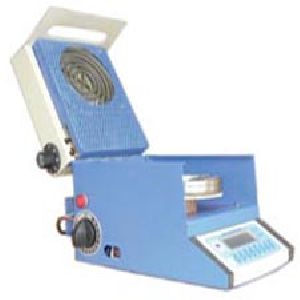
Digital Moisture teller
Get Price Quote
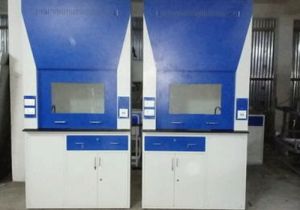
Fume Hood
Get Price Quote
From the first day of our inception, we have been involved in manufacturing and supplying the superior grade of Fume Hood. The offered fume hood is used in various industrial and commercial complexes as ventilation devices, which limits exposure to toxic fumes or dusts. Total quality management at different stage of production, ensures that the quality of the offered fume hood is never compromised.
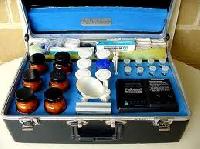
Soil Testing Kit
Get Price Quote
We are offering soil testing kit.testing proceduressoil testing kit testing soil sample collection and preparation: depending on the type of soil, divide the field in different sampling units. The soil sample collected should be representative of the area sampled. a good representative soil sample is the first requirement for a reliable soil testing. A field can be treated as a single sampling unit only if it is appreciably uniform in all respects. Separate sets of composit samples need to be taken for separate type areas. The sample should be taken in zigzag pattern. For field crops, sampling depth of 15-20 cms is desired. For pasture crop, a 10 cm. Depth is normally sufficient. Sampling tools : for sampling soft moist soil, spade or khurpi is quite satisfactory. for harddry soil, screw type auger is more convenient. sample collection: if the spade or khurpi is used, a v shaped cut may be first made up to plough layer and uniform 1.5 cm slice taken out. The collected soil sample should be thoroughly mixed on a clear piece of cloth, polythene sheet or thick paper and the bulk reduced by "quartering" so that about 500 gm. (12 kg.) of composite sample is retained. In 'quartering', the soil is spread uniformally over a sheet of brown paper or polythene and divided in to four equal square portions. Discard the two diagonally opposite squares while retaining the other two squares. Mix the retained soil sample and repeat the process of discarding until about 12 kg. Sample is balance. sample storage: the sample must be kept in cloth or polythene bag with suitable identification. sample preparation: it is preferable to air dry samples in shade. The samples may be mixed during drying to expose fresh surfaces. The dried samples are crushed gently using pestle & morter and sieved through 2 mm sieve. Pestle & morter may be of wood, porelaim or stainless steel. Sieve can be steel or nylon. Stones, pieces of roots or leaves etc. may be removed from the sample. The soil sample passed through 2 mm sieve may be used for analysis of n, p, k & ph. For analysis of organic carbon, small portion of soil sample is further ground, using pestle & morter, to make it a powder to pass through 0.5 mm sieve. ph colour comparator soil ph test contains a colour comparator, which has 10 slots ranging from ph value of 4.5 (highly acidic) to 9.0 (highly alkaline). phosphorous & nitrogen colour comparator the phosphorous & nitrogen test contains a colour comparator, which has 5 nos. Colour slots of blue red colour of varying intensity corresponding to the phosphorous nitrogen content in the soil sample. organic carbon colour comparator the organic carbon test contains colour comparator which has 6 nos. Colour slots ranging from 0 to 1.0 % organic carbon in soil sample. matching the colour for matching the colour of test water with the colours on the comparator, place the glass test bottle in the comparator. Hold the comparator against light, placing it between source of daylight and the observer, at his eye level. Observe the colour of test water. Match the colour of test bottle with colours on comp rator. read the phosphorousnitrogenorganic carbon content directly on the comparator. in case colour of test water falls between two colour slots on comparator, reading may be taken as the mid-point between the two colour slots. proper handling of chemicals 1. Carefully follow all instructions. 2. Some of the reagents contain strong acids. Handle these carefully. 3. Tighten all caps immediately after use. Do not exchange caps. 4. Avoid prolonged exposure to direct sunlight. 5. Keep reagents away from fire and heat. 6. Wash & rinse all apparatus immediately after use. Use bottle brush for cleaning of bottles, wherever necessary. 7. Keep away from reach of children. soil - ph test test procedure 1. Take reagent ph-1 in test bottle no. 1 up to 5 ml. Mark. 2. Add 2 flat spoonful of soil (2gm.) in test bottle no. 1 with the help of funnel. 3. Put cap and mix by gentle inversion for one minute. (do not shake vigorously. Mix for one minute only) allow the bottle to stand for 10 minutes. Soil will settle & separate to leave clear liquid layer on the top. 4. Place the bottle no. 1 in ph colour comparator and match the colour of top liquid layer with colours on the comparator. Read soil ph directly on comparator (refer note for method of colour matching). (for ease of matching colours, you may carefully decant the upper clear liquid from test bottle no. 1 to another clean test bottle no. 1 and then match the colour with ph colour chart.) available phosphorous (p) in soil test procedure 1. Take in test bottle no. 1, phosphorous reagent ap-1 up to 6 ml. Mark. 2. Using funnel, add one flat spoonful (1gm.) of soil in test bottle no. 1 3. Put cap and mix by gentle inversion for one minute. (do not shake vigorously. Mix for one minute only) allow the bottle to stand for 5 minutes. Soil will settle & separate to leave clear liquid layer on the top. 4. Carefully draw upper clear liquid in dropper and transfer the same to test bottle no. 2 to make level up to 3 ml. Mark. (do not pull up any soil in the dropper. To avoid agitation of soil, squeeze bulb of dropper before inserting its tip into liquid. Release bulb slowly to draw clear liquid.) 5. To 3ml. Liquid in bottle no. 2, add 6 drops of phosphorous reagent ap-2 and mix gently by swirling. Add 3 drops of reagent ap-3. Put cap and mix well. Blue colour will develop in bottle no. 2. 6. Place the bottle in phosphorous colour comparator & match the colour of bottle with the colours on phosphorous colour comparator. (refer the note regarding colour comparator) read the available phosphorous (as p) directly on the colour comparator. available nitrogen (n) in soil test procedure 1. Take in test bottle no. 1, nitrogen reagent an-1 up to 6 ml. Mark. 2. Using funnel, add one flat spoonful of soil (1gm.) in test bottle no. 1 3. Put cap and mix by gentle inversion for one minute. (do not shake vigorously. Mix for one minute only) allow the bottle to stand for 5 minutes. Soil will settle & separate to leave clear liquid layer on the top 4. In clean bottle no. 2, carefully transfer 2 ml of upper clear liquid from bootle no. 1, using dropper. (carefully draw liquid from bottle no. 1 in dropper. Do not pull up any soil in the dropper, while drawing liquid. To avoid agitation of soil, squeeze bulb of dropper before inserting tip into liquid. Release bulb slowly to draw clear liquid.) 5. To test bottle no. 2, add 4 drops of reagent an-2. & mix gently. 6. To test bootle no. 2, add 4 drops of reagent an-3, put cap & mix gently. Wait for 5 minutes. 7. After 5 minutes, mix gently & place the bottle in nitrogen colour comparator & match the colour of bottle with colours on comparator.(refer note regarding colour comparator.) 8. Read the available nitrogen directly on comparator. organic carbon in soil test procedure 1. Using 100mg. Spoon, take one spoonful (100mg.) of finely ground soil in test bottle no. 1. 2. to the bottle no. 1, add 0.5 ml. Of reagent oc-1 with the help of 1 ml.green coloured syringe (do not use red coloured syringe) 3. To the bottle no. 1, add 80 drops of reagent) oc-2 and mix by gentle swirling. (caution! reagent oc-2 is a strong acid. Handle carefully avoids contact.) put cap. Wait for 30 minutes. 4. add reagent oc-3 to make the level in bottle no. 1 up to 5 ml. Mark. Mix by gentle swirling. Allow the bottle to stand for 5 minutes. Soil will settle & separate to leave clear liquid layer on the top. 5. place the bottle in organic colour comparator and match the colour of top liquid layer with the colour slots on comparator by holding the comparator against day light. (please refer note regarding organic carbon colour comparator) 6. read the percentage organic - carbon in the soil (%) directly on the colour comparator. (for ease of matching colours, you may carefully decant the upper clear liquid from test bottle no. 1 to another clean test bottle no. 1 and then match the colour with colour comparator.) available potassium (k) in soil test procedure 1. Take in test bottle no. 1, potassium reagent ak-1 up to 6 ml. Mark. 2. Using funnel, add two flat spoonfuls (2gm.) of soil in test bottle no. 1 3. put cap and mix by gentle inversion for one minute. (do not shake vigorously. mix for one minute only) allow the bottle to stand for 5 minutes. Soil will settle & separate to leave clear liquid layer on the top. 4. Carefully draw upper liquid in dropper and transfer the same to another clean bottle no.2, to make level up to 2 ml. Mark. (do not pull up any soil in dropper. To avoid agitation of soil, squeeze bulb of dropper before inserting its tip in to liquid. Release bulb slowly to draw clear liquid in to the dropper.) 5. To 2 ml. Liquid in bottle no. 2, add one tablet of potassium reagent ak-2. Do not put cap. Mix by swirling. Allow tablet to dissolve completely. Mix by swirling intermittently to assist dissolution (it may take 5-6 minutes to dissolve the tablet completely) purple colour will develop in bottle no. 2. Proceed further only after complete dissolution of tablet. 6. Take potassium reagent ak-4 in the 1 ml syringe. Add reagent ak-4 to bottle no. 2, two drops at a time, and mix gently after each addition. Keep count of drops and continue addition until colour changes from purple to blue. Count the no. Of drops of reagent ak-4 required for colour change. use red coloured 1 ml. Syringe for taking potassium. Reagent ak-4. (do not use green coloured syringe)
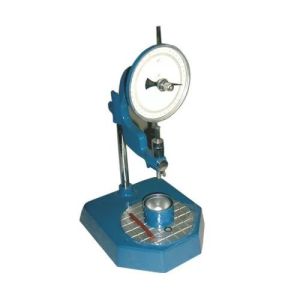
Bitumen Penetrometer
36,000 Per Piece

Fume Hood
Get Price Quote
Fume Hood are mandatory for chemical, industrial and research laboratories for the removal of toxic corrosive fumes and gases becomes critical. All fumes , gases while performing various test are removed by ventilating hood by means of exhaust blowers mounted outside the room. Our fume hoods are manufactured from best quality elector Galvanized sheets of 200G which provides better protection from acid fumes in the lab.

sand testing machine
Get Price Quote
We are pioneers in offering patrons with a huge assortment of Sand Equivalent Test Apparatus at market leading prices. Manufactured with precision, this range is accredited in various sectors of the industry to function as per patrons needs and demands. This range is available with us in various sizes, grades and other detailed specifications as per patrons needs and demands. Moreover, a customized range can also be availed from us that suits patrons.
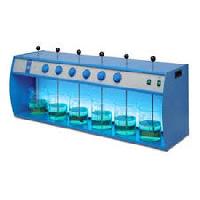
Jar Test Apparatus
Get Price Quote
amfah dehumidifier, Novita Humidifier, Novita Dehumidifier, Dehumidifier

Proctor Compaction Apparatus
Get Price Quote
Humidity Temperature Controller, Altimeter

Vicat Needle Test Apparatus
Get Price Quote
Diesel Concrete Vibrator, Rapid Clamp, Meters Leveling Staff

sand preparation equipments
Get Price Quote
sand preparation equipments, Sand Mix Muller / Wheel Type

Soil testers
Get Price Quote
Soil testers, Water Testing Equipment, Food Analytical Services

Sand Testing Machine - GCS
Get Price Quote
Sand Testing Machine - GCS, Permeability Meter

Automatic Penetrometer
Get Price Quote
Automatic Penetrometer, lab mixer

Sand Replacement Method Field Density Apparatus
Get Price Quote
Sand Replacement Method Field Density Apparatus

Light Compaction Equipment
Get Price Quote
Light Compaction Equipment, earth movers, Hydraulic Excavator, Wheel Loader

Fume Hood
Get Price Quote
gel documentation, electrophoresis, Laboratory Fermenter